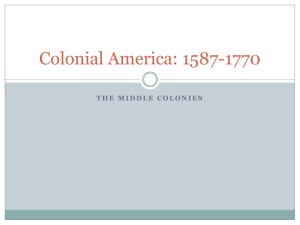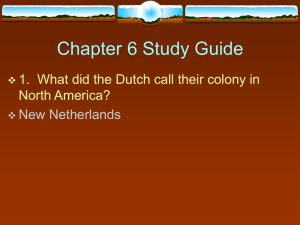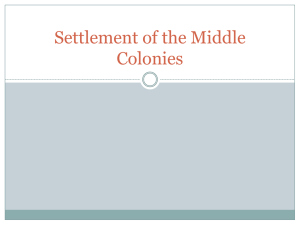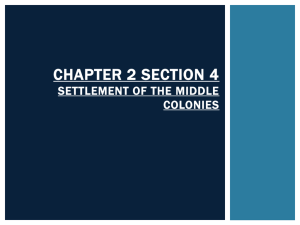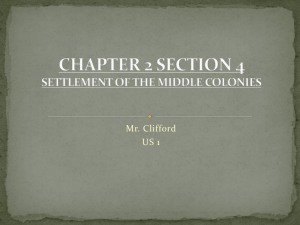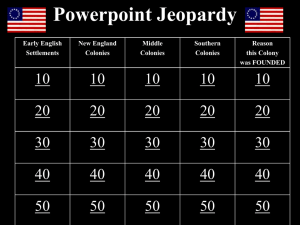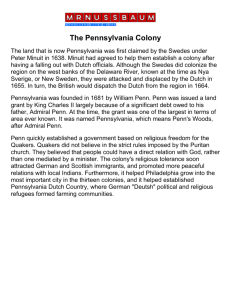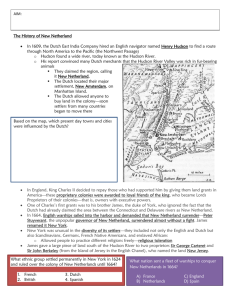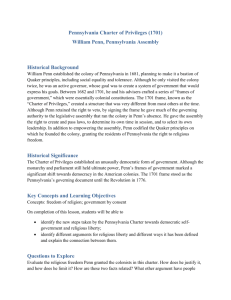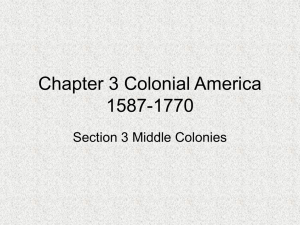The Middle Colonies
advertisement
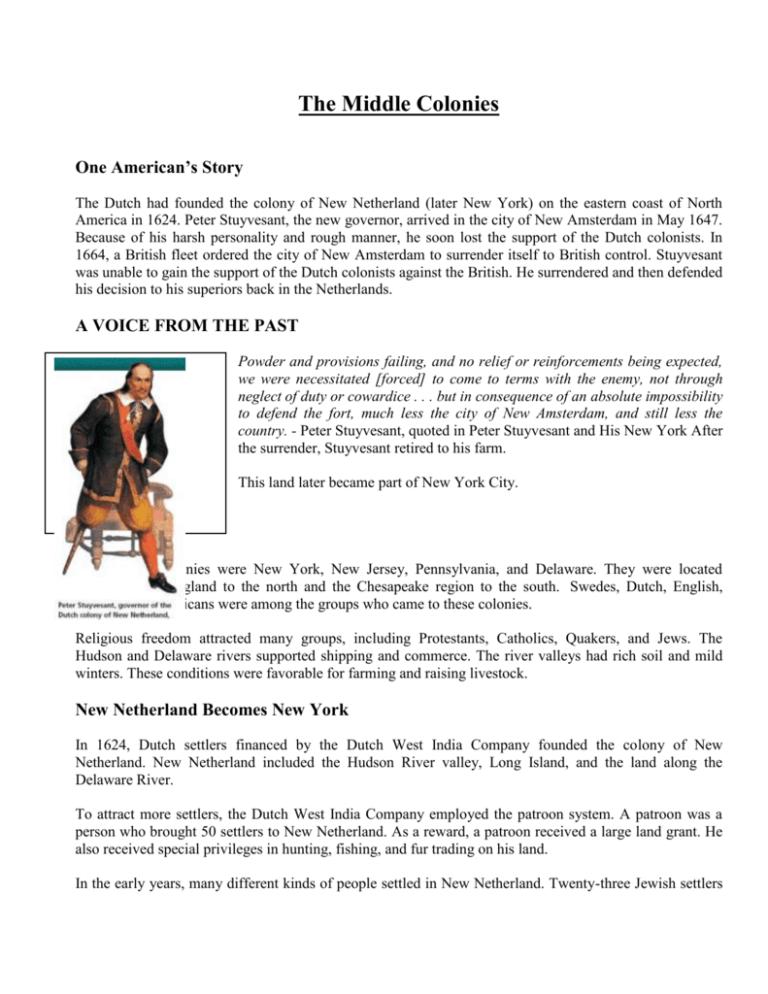
The Middle Colonies One American’s Story The Dutch had founded the colony of New Netherland (later New York) on the eastern coast of North America in 1624. Peter Stuyvesant, the new governor, arrived in the city of New Amsterdam in May 1647. Because of his harsh personality and rough manner, he soon lost the support of the Dutch colonists. In 1664, a British fleet ordered the city of New Amsterdam to surrender itself to British control. Stuyvesant was unable to gain the support of the Dutch colonists against the British. He surrendered and then defended his decision to his superiors back in the Netherlands. A VOICE FROM THE PAST Powder and provisions failing, and no relief or reinforcements being expected, we were necessitated [forced] to come to terms with the enemy, not through neglect of duty or cowardice . . . but in consequence of an absolute impossibility to defend the fort, much less the city of New Amsterdam, and still less the country. - Peter Stuyvesant, quoted in Peter Stuyvesant and His New York After the surrender, Stuyvesant retired to his farm. This land later became part of New York City. The Middle Colonies were New York, New Jersey, Pennsylvania, and Delaware. They were located between New England to the north and the Chesapeake region to the south. Swedes, Dutch, English, Germans, and Africans were among the groups who came to these colonies. Religious freedom attracted many groups, including Protestants, Catholics, Quakers, and Jews. The Hudson and Delaware rivers supported shipping and commerce. The river valleys had rich soil and mild winters. These conditions were favorable for farming and raising livestock. New Netherland Becomes New York In 1624, Dutch settlers financed by the Dutch West India Company founded the colony of New Netherland. New Netherland included the Hudson River valley, Long Island, and the land along the Delaware River. To attract more settlers, the Dutch West India Company employed the patroon system. A patroon was a person who brought 50 settlers to New Netherland. As a reward, a patroon received a large land grant. He also received special privileges in hunting, fishing, and fur trading on his land. In the early years, many different kinds of people settled in New Netherland. Twenty-three Jewish settlers arrived in 1654, and others soon followed. Later, Africans were brought to the colony as slaves and indentured servants. Many Puritans also came. Peter Stuyvesant, the colony’s governor, wanted to add land to New Netherland. He attacked the nearby charter colony of New Sweden in 1655. This colony was located along the Delaware River. The main settlement was Fort Christina (later named Wilmington, Delaware). It had been settled by Swedes in 1638. After an attack by the Dutch, the Swedes surrendered Fort Christina. England’s King Charles II decided that his brother, the Duke of York, should drive the Dutch out of New Netherland. The Dutch colony was a threat to England because of its trade. It was also a threat because of its expanding settlements and its location. There were English colonies in New England to the north and Virginia to the south. As you have seen, when the duke’s ships appeared off New Amsterdam in August 1664, the colony surrendered. New Netherland became the proprietary colony of New York. The Duke of York was now the proprietor, or owner, of the colony. New Jersey, Pennsylvania, and Delaware The Duke of York had become the largest single landowner in America. He gave part of his claim, the province of New Jersey, to his friends Sir George Carteret and Lord John Berkeley in 1664. They encouraged settlers to come by promising freedom of religion. They also promised large grants of land and a representative assembly. William Penn became another large landowner in America. Born into a wealthy English family, Penn joined the Quakers, to his father’s disapproval. The young Penn was attacked for his Quaker beliefs. King Charles II owed the Penn family money. In repayment, in 1681 he gave Penn a large piece of land in America that came to be called Pennsylvania. The name means “Penn’s woods.” Penn used this land to create a colony where Quakers could live according to their beliefs. Among other things, the Quakers believed that all people should live in peace and harmony. They welcomed different religions and ethnic groups. In Pennsylvania, Penn extended religious freedom and equality to all. He especially wanted the Native Americans to be treated fairly. In a letter to them in 1681, Penn said, “May [we] always live together as neighbors and friends.” Penn’s policies helped make Pennsylvania one of the wealthiest of the American colonies. Many settlers came to Pennsylvania seeking religious freedom and a better life. In 1704, Penn granted the three lower counties of Delaware their own assembly. The counties later broke away to form the colony of Delaware.
